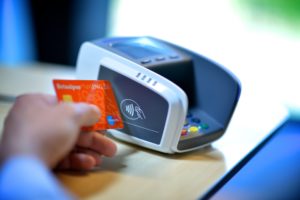Blog
Safety Issues Surrounding Contactless Payments

The world of card payments has changed dramatically over the last several years. One of the most prominent trends increasing in popularity and use is contactless payment. Leaning on technology of near field communication, or NFC, contactless payments allow cardholders to avoid swiping or inserting a card into a reader. Instead, getting close to an NFC reader enables the transaction to take place with ease and convenience.
A driving force behind the increased popularity in contactless payments is the perceived security boost provided to both consumers and merchants. However, NFC payment technology is not without fault, nor is it an ironclad process free of security threats. It is essential to recognize the safety concerns surrounding contactless payments, as well as ways to protect personal information from identity theft and payment fraud.
Security Concerns for Consumers
Although NFC technology offers more security than more traditional card readers, consumers and businesses alike need to be aware of the issues that may arise. The most common include:
Eavesdropping – contactless payments are completed by transmitting data through the air from the cardholder to the card reader. Criminals may have an opportunity to “listen in” on the transaction. If successful, fraudsters can gather the card details or personal information for their own use. Cards need to be incredibly close to the NFC reader for a purchase to take place, so eavesdropping is challenging to accomplish. However, it is a real threat in the world of contactless payments.
Out-of-date Applications – cardholders who utilize contactless payments can do so through mobile applications. When apps are up to date, there are fewer instances of security issues when using NFC technology. When these applications are a version or more old, personal information and card details may be at risk.
Stolen Device – Contactless payment details are maintained in an application on a cardholder’s mobile device. Theft of that device could prove problematic. Criminals may gain access to the individual’s personal information and use it to steal their identity.
Keeping Your Information and Identity Safe
The security threats that accompany NFC payment technology are real. They can lead to a devastating outcome for cardholders and the businesses that accept these payments. If criminals are able to gain access to personal identifying information, such as name, address, or card number and expiration date, they may have an opportunity to create new accounts or divert funds for their personal gain. Although it is impossible to prevent identity theft and payment fraud altogether, there are simple steps you can take to ensure you are safeguarding your information.
1 – Keep an Eye on Your Credit
Every consumer establishes credit throughout their lifetime. This comes from taking out credit accounts like credit cards or having a home or student loan. Regardless of how credit is established, three main credit bureaus maintain details of credit activity in personal credit reports. Individuals can access each of their three credit reports for free once per year. Checking credit consistently provides an opportunity to identify issues with fraudulent accounts opened in your name. If an account is showing on a credit report that you did not establish, get in contact with the company to determine what took place. This can be a leading indicator of identity theft and fraud.
2 – Check Bank Account Statements Closely
Similar to checking credit reports, paying attention to bank account statements helps thwart identity theft issues. Erroneous charges or transfers to outside accounts could indicate someone else has your card or account information. Work with the bank to correct these issues and request new account numbers or card details if necessary.
3 – Lock Devices
NFC technology is difficult to hack, but a stolen device can lead to unfortunate outcomes in identity theft and payment fraud. Locking a device and having a method to shut it down remotely can assist in reducing these threats.
4 – Update Passwords
Whether on a mobile device or computer, regularly updating passwords can overcome issues of identity theft and fraud. Hackers are always searching for ways to gain access to personal, secure information. Having simple passwords or the same password for every account could lead to disaster. Make a habit of updating passwords every month. Consider the use of two-factor authentication as well.
Although the security issues surrounding contactless payments are minimal compared to traditional card use, they still exist. It is crucial for both merchants and consumers to be aware of these concerns. Understanding what safety risks plague the payment environment along with strategies for protecting personal information go a long way in reducing security threats.
